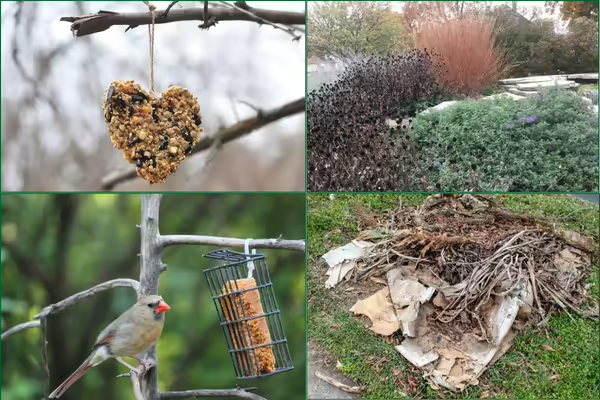
Winter can be a challenging season for wildlife, but with thoughtful landscaping practices, homeowners can create spaces that nurture birds, insects, and other creatures. By providing food, shelter, and overwintering habitats, you can ensure your yard is a haven for wildlife while enriching your connection to nature.
The Bird-Insect Connection: A Vital Food Source
Birds and insects share a profound ecological relationship that is especially important in the spring. Ninety-six percent of North American terrestrial bird species rely on insects, particularly caterpillars, to raise their young. Caterpillars are rich in protein and fat, providing the necessary nutrition for nestlings to grow and thrive. Without an adequate supply of insects, many bird species would struggle to reproduce successfully.
Maintaining a landscape that supports overwintering insects—such as butterflies, moths, and beetles—ensures a food source for birds come spring. Practices like leaving leaf litter, preserving dead plant stems, and avoiding pesticides can significantly contribute to insect populations.
Nutrition needs of birds in winter
Winter is a time of scarcity for many birds, requiring them to rely on high-energy foods to survive. Seeds, nuts, and suet are critical dietary staples, offering the fat and calories birds need to maintain their body heat. Common winter visitors such as chickadees, nuthatches, and woodpeckers benefit from the following:
- Seeds: Black oil sunflower seeds are a favorite among many species due to their high-fat content and thin shells.
- Nuts: Unsalted peanuts provide energy-dense nutrition.
- Suet: This animal fat-based food is excellent for sustaining birds during cold weather.
When feeding birds, responsible practices are essential. Clean feeders regularly to prevent the spread of disease and offer food in moderation to supplement natural foraging rather than replace it.
Providing shelter: A winter necessity
Beyond food, birds need safe places to roost and escape predators and harsh weather. Evergreen trees, dense shrubs, and brush piles are excellent options for providing cover. You can also install roosting boxes, which are specially designed to keep birds warm by trapping their body heat.
Songbirds often seek protection in:
- Evergreens: Pine (Pinus spp.), spruce (Picea spp.), and cedar (Juniperus spp.) are a few evergreen species that offer year-round cover.
- Brush piles: Made from fallen branches and yard clippings, these provide excellent hiding spots.
- Cavity trees: Dead trees and snags are natural shelters for many species. Leave limbs and dead trees in the landscape when it is safe to do so.
Creating overwintering habitats for insects
Supporting insects during the winter is vital for sustaining bird populations and maintaining ecosystem health. Many insects overwinter in leaf litter, hollow stems, or underground, emerging in spring to pollinate plants and serve as prey for birds.
Here are some tips for creating insect-friendly winter landscapes:
- Leave the Leaves: Allow fallen leaves to remain on garden beds or in designated areas. Leaf litter provides insulation and shelter for insects like fireflies and butterflies.
- Preserve Plant Stems: Many native bees and other insects overwinter in hollow or pithy stems. Delay cutting back plants until late spring.
- Avoid Pesticides: Pesticides can harm overwintering insects. Opt for natural pest control methods instead.
- Add Logs and Rocks: Decaying logs and rock piles create microhabitats for beetles, ants, and other insects.
By fostering an insect-friendly yard, you’ll also benefit from improved soil health and pollination services.
Design a wildlife-friendly winter landscape
A landscape that supports winter wildlife incorporates a diversity of native plants, structural variety, and sustainable practices. Here are some actionable ideas:
- Plant Natives: Native plants are adapted to local conditions and support native wildlife. Winterberry, elderberry, and American holly provide food and shelter.
- Provide Water: A heated birdbath ensures access to fresh water even when natural sources are frozen.
- Build Habitat Layers: Incorporate ground cover, shrubs, and trees to create a multi-dimensional habitat.
- Reduce Lawn Areas: Convert portions of lawn into meadows or native plant gardens.
Small steps, big impact
Managing your winter landscape for wildlife doesn’t require a complete overhaul. Even small actions like leaving a brush pile or offering supplemental sources of food can make a difference. By creating a space that meets the needs of birds and insects, you are contributing to a healthier, more balanced ecosystem.
This information is from the December 2024 issue of The Outsider Newsletter. Download it here
University of Illinois Extension develops educational programs, extends knowledge, and builds partnerships to support people, communities, and their environments as part of the state's land-grant institution. Extension serves as the leading public outreach effort for University of Illinois Urbana-Champaign and the College of Agricultural, Consumer and Environmental Sciences in all 102 Illinois counties through a network of 27 multi-county units and over 700 staff statewide. Extension’s mission is responsive to eight strategic priorities — community, economy, environment, food and agriculture, health, partnerships, technology and discovery, and workforce excellence — that are served through six program areas — 4-H youth development, agriculture and agribusiness, community and economic development, family and consumer science, integrated health disparities, and natural resources, environment, and energy.